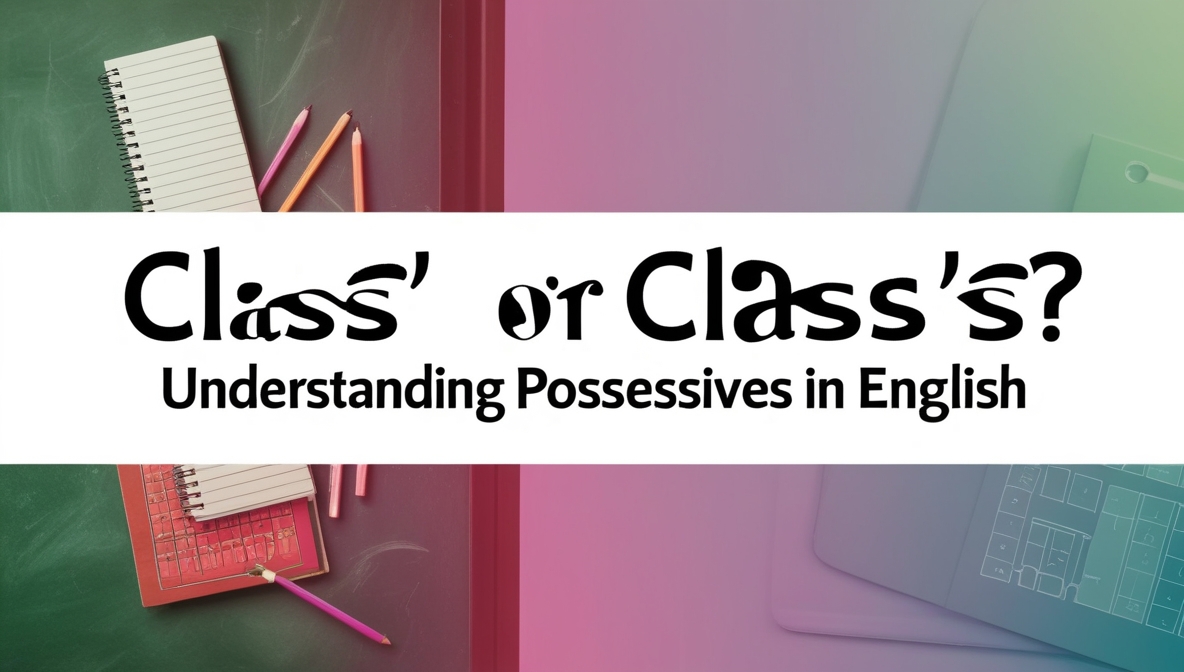When it comes to the English language, possessives can often lead to confusion, even among native speakers. Among these, the words “class’” and “class’s” frequently puzzle writers and speakers alike. This article will delve into the nuances of possessives, particularly focusing on these two forms, providing clear explanations and practical examples to help clarify their usage.
What Are Possessives?
Possessives indicate ownership or association. They show that something belongs to someone or something. In English, the most common way to form a possessive is by adding an apostrophe and, in some cases, an “s”. For instance, if you have a book that belongs to John, you would say “John’s book.”
The Basic Rules of Possessives
Singular Nouns
For singular nouns, the general rule is to add an apostrophe followed by an “s.”
- Example: “The dog’s leash” indicates that the leash belongs to the dog.
Plural Nouns
For plural nouns that already end in “s,” you simply add an apostrophe after the “s.”
- Example: “The dogs’ park” indicates a park that belongs to multiple dogs.
Plural Nouns Not Ending in “s”
For plural nouns that do not end in “s,” you still add an apostrophe followed by an “s.”
- Example: “The children’s toys” indicates toys that belong to children.
The Specific Case of “Class”
Now let’s focus on “class.” The word “class” can be used in various contexts, from education to social groups. Understanding how to correctly form its possessive can enhance clarity in your writing.
Class’s
The standard form for the possessive of “class” is “class’s.” This is true for a singular noun that refers to a group.
- Example: If you are discussing the homework assigned to a single class, you would say, “The class’s homework was challenging.”
Here, the homework belongs to the class, and the use of “class’s” clearly indicates that ownership.
Class’
However, you may see “class’” used in some contexts, particularly when dealing with certain styles of writing or when following specific guidelines. Some style guides, particularly British English ones, may accept the shorter form, especially when the noun ends with an “s.”
- Example: If you were discussing the performance of several classes, you might say, “The classes’ activities were engaging.”
In this case, the possessive of “classes” is formed by adding just an apostrophe, as it already ends with an “s.”
When to Use Each Form
While the conventional rule suggests using “class’s” for singular possessive and “class’” for plural possessive, some may argue about stylistic preferences. In formal writing, it’s generally safer to stick with “class’s.”
For example:
- Correct: “The class’s project was well-received.”
- Less Common (but acceptable in some contexts): “The class’ project was well-received.”
Scenarios to Illustrate Usage
Scenario 1: In an Educational Context
Imagine a teacher discussing the progress of her students. She might say, “The class’s overall performance in the exam was impressive.” Here, she is referring to one specific class, so “class’s” is the correct form.
Scenario 2: Discussing Multiple Classes
Now consider a situation where you’re talking about the activities of multiple classes in a school. You might say, “The classes’ field trips were educational and fun.” In this case, “classes’” shows that the field trips belong to more than one class.
Scenario 3: A More Casual Setting
In a casual conversation, someone might say, “Did you see the class’s new project?” This form is clear and widely accepted, making it an easy choice for everyday discussions.
Common Mistakes to Avoid
- Using “class’” for singular contexts: Remember that for a single class, you should stick with “class’s.”
- Confusing possessives with contractions: Ensure you’re not mixing up possessives with contractions. For example, “class’s” is possessive, while “class is” would be contracted as “class’s” in informal contexts. This can be misleading.
- Overlooking context: Always consider the context. If you’re discussing multiple classes, then “classes’” is appropriate, but if it’s one class, it should be “class’s.”
Conclusion
Understanding the difference between “class’” and “class’s” is essential for clear communication. By adhering to the rules of possessives, you can enhance your writing and avoid common pitfalls. Whether you’re in an academic setting, writing a report, or simply engaging in conversation, using the correct form will ensure your message is conveyed accurately.
In summary, remember:
- Use “class’s” for singular possessive.
- Use “classes’” for plural possessive.
- Be mindful of context and style guides that may influence your choice.
With practice, mastering the intricacies of possessives will become second nature, allowing you to express ownership clearly and confidently in your writing.

